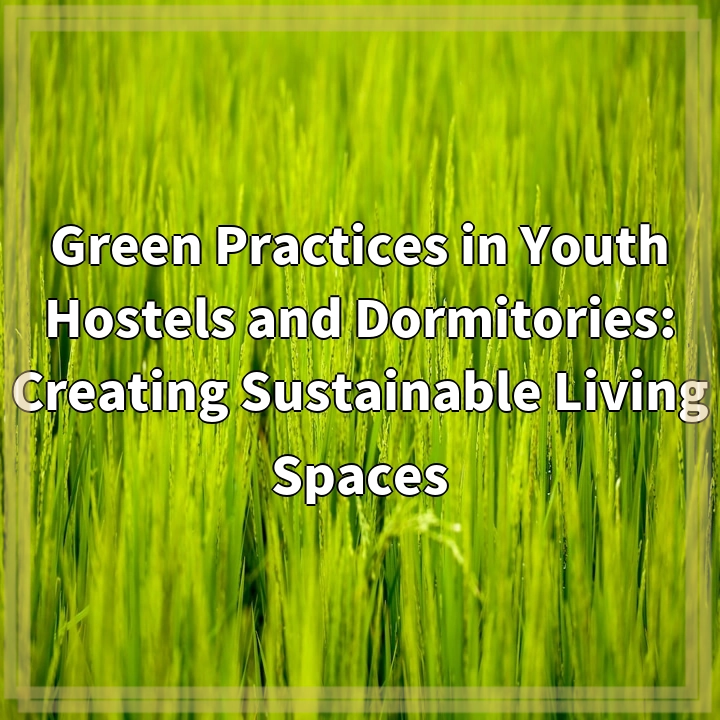
What it is:
Youth hostels and dormitories are popular accommodation options for budget-conscious travelers and students. In recent years, there has been a growing focus on incorporating green practices into these living spaces. Green practices in youth hostels and dormitories refer to the implementation of sustainable initiatives that minimize environmental impact and promote eco-friendly living.
These green practices can encompass various aspects, such as energy and water conservation, waste reduction, sustainable transportation, and the use of environmentally friendly materials. The aim is to create living spaces that are not only affordable and comfortable but also environmentally conscious and socially responsible. By adopting these practices, youth hostels and dormitories can contribute to mitigating climate change and protecting natural resources.
Real-world problems:
Despite the increasing interest in green practices, there are several challenges that youth hostels and dormitories face in implementing sustainable living spaces.
1. Limited financial resources: Many youth hostels and dormitories operate on tight budgets, making it difficult to invest in expensive eco-friendly technologies and infrastructure upgrades. This financial constraint can hinder the adoption of green practices.
2. Lack of awareness and education: Some hostel owners and managers may not be aware of the benefits and importance of sustainable practices. There might be a lack of knowledge about cost-effective solutions that can be implemented. Educating hostel staff and residents about the environmental impact of their actions and providing them with eco-friendly alternatives is vital.
3. Older infrastructure: Many youth hostels and dormitories are housed in older buildings, which may not be designed with eco-efficiency in mind. Retrofitting these structures to meet sustainability standards can be challenging and costly.
4. High occupancy rates and energy consumption: Youth hostels and dormitories often have high occupancy rates, resulting in increased energy and water consumption. Proper monitoring and control systems need to be in place to manage and reduce usage effectively.
5. Waste management: With a large number of people living in one space, waste management can be a significant challenge. Implementing recycling programs, composting initiatives, and reducing single-use plastics can require careful planning and effective communication with residents.
Addressing these real-world problems requires a collaborative effort from hostel owners, staff, residents, and the wider community. By finding innovative solutions and working together, youth hostels and dormitories can overcome these challenges and create sustainable living spaces that prioritize environmental stewardship.

Solutions for Green Practices in Youth Hostels and Dormitories
Implementing sustainable living spaces in youth hostels and dormitories may present challenges, but there are effective solutions that can overcome these obstacles and promote a greener environment.
1. Seek funding and financial support:
Hostel owners and managers can explore funding opportunities, such as grants or subsidies, to invest in eco-friendly technologies and infrastructure upgrades. They can also consider partnerships with sustainability-focused organizations or businesses to access financial support and expertise.
2. Raise awareness and education:
Hostel staff and residents should be educated about the environmental impact of their actions and the benefits of green practices. This can be done through training programs, informational campaigns, and workshops that promote eco-friendly behaviors and provide practical tips.
3. Retrofit existing infrastructure:
Older buildings can be retrofitted to improve energy efficiency and sustainability. This can include installing energy-efficient lighting, implementing insulation measures, and upgrading heating and cooling systems. Adapting water management systems, such as low-flow fixtures and rainwater harvesting, can also reduce consumption.
4. Implement energy and water monitoring systems:
Installing smart meters and monitoring systems can help track energy and water usage in youth hostels and dormitories. The data collected can identify areas of high consumption and guide efforts to reduce waste through behavior change and more efficient equipment.
5. Establish waste management programs:
Developing comprehensive waste management programs is crucial in these communal living spaces. This can involve setting up recycling stations, providing clear signage and education on proper waste sorting, promoting the use of reusable items, and implementing composting initiatives.
6. Collaborate with the community:
Engaging with the local community can create mutually beneficial partnerships. Hostels and dormitories can collaborate with local businesses, organizations, and institutions to implement sustainable practices and share resources. This can include establishing bulk purchasing agreements for eco-friendly products or collaborating on events that promote environmental awareness.
By implementing these solutions, youth hostels and dormitories can play a vital role in creating sustainable living spaces that minimize environmental impact and inspire residents to adopt eco-friendly behaviors.















